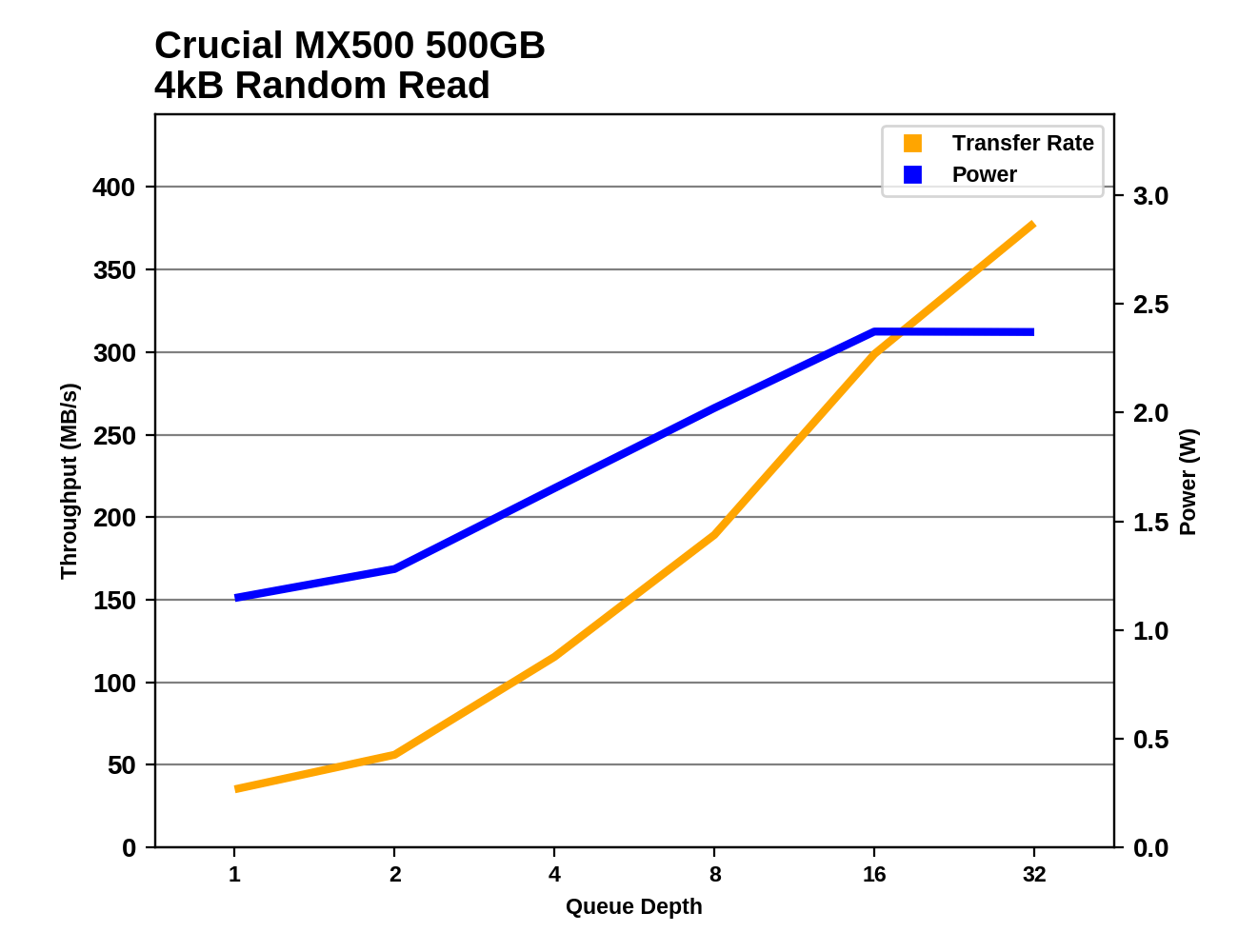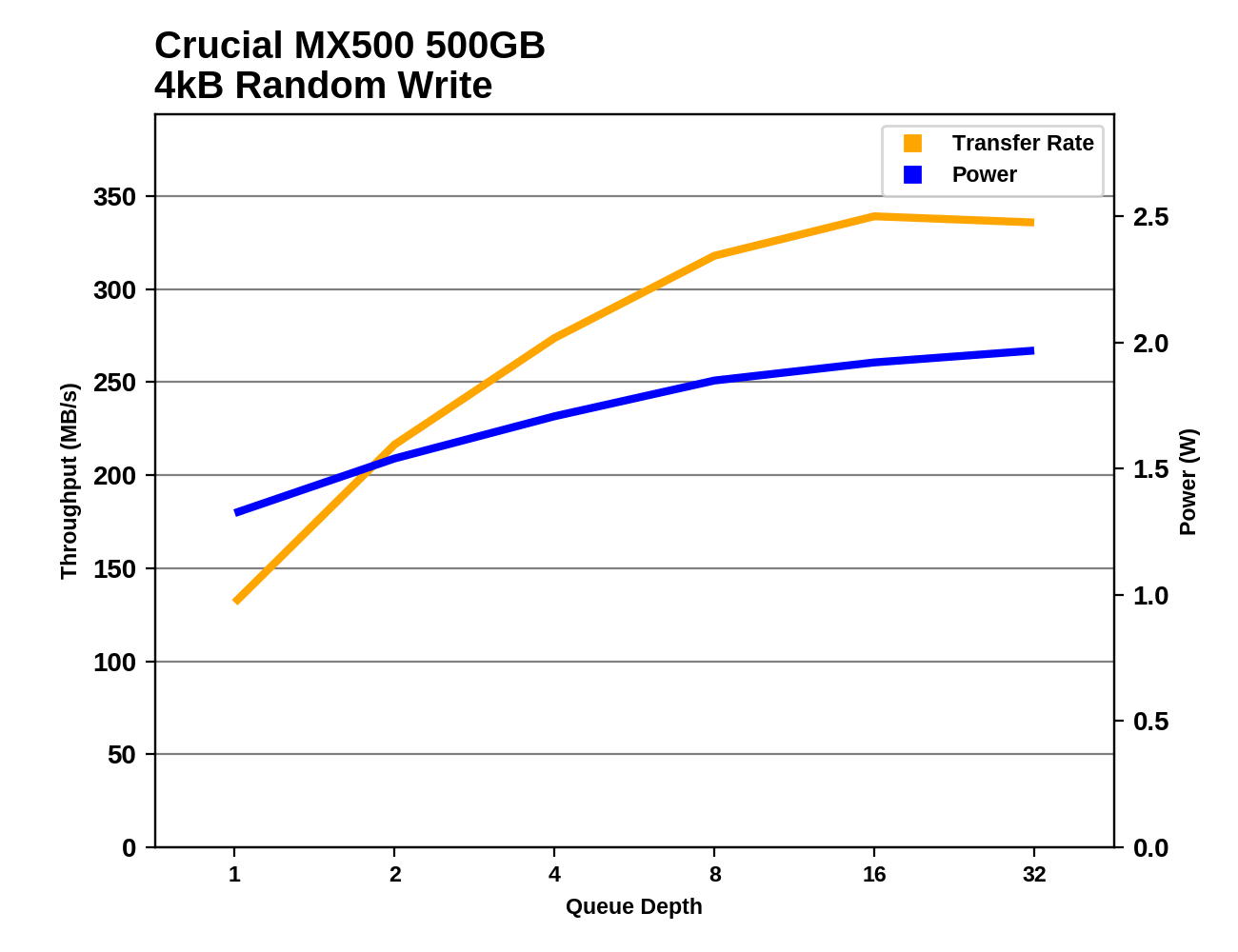The Crucial MX500 500GB SSD Review: A Second Look
by Billy Tallis on February 2, 2018 9:30 AM ESTRandom Read Performance
Our first test of random read performance uses very short bursts of operations issued one at a time with no queuing. The drives are given enough idle time between bursts to yield an overall duty cycle of 20%, so thermal throttling is impossible. Each burst consists of a total of 32MB of 4kB random reads, from a 16GB span of the disk. The total data read is 1GB.

The 500GB Crucial MX500 isn't quite as fast as its 1TB sibling on the burst random read performance test, but it still scores better than any other TLC we've tested. The Samsung 860 EVO might be able to beat the MX500's performance here when it arrives, but probably not my much.
Our sustained random read performance is similar to the random read test from our 2015 test suite: queue depths from 1 to 32 are tested, and the average performance and power efficiency across QD1, QD2 and QD4 are reported as the primary scores. Each queue depth is tested for one minute or 32GB of data transferred, whichever is shorter. After each queue depth is tested, the drive is given up to one minute to cool off so that the higher queue depths are unlikely to be affected by accumulated heat build-up. The individual read operations are again 4kB, and cover a 64GB span of the drive.

With longer queue depths and test run times, the MX500's random read performance falls from first place to merely above average. The MX500 is still the fastest Crucial SSD, but it is substantially slower than the Samsung SATA drives and is not quite as fast as the Intel 545s.

The power efficiency of the Crucial MX500 during the random read test is better than any previous Crucial SSD, but the Intel 545s and Samsung 850 EVO outscore it significantly. The 860 EVO will only widen this gap.
 |
|||||||||
The Intel 545s and the Crucial MX500 perform about the same until QD16 where the 545s starts to level off. The Samsung 850 EVO starts building a lead on the MX500 at much lower queue depths, so it reach es peak performance much earlier. Both of those competitors use less power than the MX500 throughout the random read test.
Random Write Performance
Our test of random write burst performance is structured similarly to the random read burst test, but each burst is only 4MB and the total test length is 128MB. The 4kB random write operations are distributed over a 16GB span of the drive, and the operations are issued one at a time with no queuing.

The burst random write speed of the 500GB Crucial MX500 is a disappointment, coming in slower than most of its competition and 25% slower than the 1TB model.
As with the sustained random read test, our sustained 4kB random write test runs for up to one minute or 32GB per queue depth, covering a 64GB span of the drive and giving the drive up to 1 minute of idle time between queue depths to allow for write caches to be flushed and for the drive to cool down.

The Crucial MX500 500GB doesn't fare quite as badly on the longer random write test. It's still one of the slower drives in the bunch, but not by such a wide margin, and it is only a little bit slower than the 1TB model.

The Crucial MX500 has good power efficiency during random writes, but both the MX300 and BX300 are slightly better, and the Samsung 860 PRO's large lead suggests the 860 EVO may also be in competition for the most efficient TLC SSD.
 |
|||||||||
The Crucial MX500 takes longer to get up to speed than the Samsung 850 EVO, but it does eventually get up to full speed matching the best SATA SSDs. Previous Crucial SSDs and the Intel 545s struggle to get up to the level of Samsung's random write performance even at QD32.










25 Comments
View All Comments
KarlKastor - Saturday, February 3, 2018 - link
I would like to see a review of old SSDs (Indlinx Barefoot, first Intel SSDs, Sandforce SSDs, crucial c300, Samsung 830 for example) and how they would compete against today's drives. The test parcours is much more detailed and challenging for the drives. Can older drives pass this test reasonable good enough or is an upgrade to a modern ssd an major improvement, besides of capacity.velanapontinha - Saturday, February 3, 2018 - link
^this^peevee - Monday, February 5, 2018 - link
Most decent SLC SATA drives should be fine, but there were terrible examples like Kingston V-series which were not much better than HDDs to begin with.But I'd like to see the tests too.
Dragonstongue - Thursday, June 21, 2018 - link
am using your charts to compare the previous results of the MX200 vs the "new" MX500, and most of the numbers and data have changed to show the MX200 as "better" than it once was, if properly tested, this should not have been shown as such.IMHO, if a drive at a specific time using a specific set of drivers etc had say a data rate of 217.85 (crucial MX200 500gb) why does this review "change" to show this same drive now being 235 (a gain of around 8%)
numbers should not be becoming "magically better" IMO, unless firmware was changed without notification, or tests were not run properly the first time around or something like that?
it is quite hard to do direct comparisons when your data does not agree with itself ^.^
MX500 is supposed to be "a fair bit quicker" in most things than MX200 or MX300 (around 18% for the 500gb models..20 odd % for the 1tb models) something is not agreeing with itself based on your data/numbers/review, this is troublesome to say the least, so I suppose my question in this regard is, how "factual" is the testing methodology being used, such as latency numbers (where the original data of MX200 read higher numbers in ms than this review does making this review appearing as if the mx200 is that much faster than it was previously (less latency)
and the power consumption was also higher previously whereas in this review it uses "less" power, the heck is up with this?
if one screwed up original testing methodology "I understand" but, if one just changes data willy nilly to suit vendors or make the older or newer stuff appear better than it actually is, screw that noise (we already have plenty enough companies/corps that do that crud daily..like Ngreedia, Apple, Intel, MSFT etc)
Just saying, had my eye on the MX500, my MX100 256gb has been working very well for me last 2.5-3 years or something like that (still at 99% life) MX200 500gb still snappy (though not quite as snappy as the MX100 for some reason and I have never had it "loaded" currently is at 92% life and yet is at least a 9 month newer drive, have not copied.deleted anywhere close to as much as it claims I have which is confusing...MX500 is supposed to have that much more endurance, but, if the MX200 seems to "chew" endurance more than it should, that is not a good thing.
I have taken all the steps I can to reduce writing to the drive (unless needed) have trim on since day 1 etc...
Anyways, compare the "original" MX200 data you reviewed dated may 22, 2015, with this review dated february 2, 2018, quite a difference in appearances from how so so the drive appeared (MX200) vs the way it "now" appears (seems like not quite a poor drive, though it never was crud drive)
https://www.anandtech.com/show/9258/crucial-mx200-...
https://www.anandtech.com/show/12263/the-crucial-m...
would say IMO, double check your info (past info) so you are not making silly mistakes if possible (I know no one is perfect by all means, but I highly doubt you keep hundreds of drives on hand so you can test them a year or 2 down the line, most review sites do not, so does this mean pulling numbers out of thin air?)
take care, love your site by all means, lots of good reading ^.^
dpjtpa - Friday, June 14, 2019 - link
This is definitely the option I will be purchasing soon